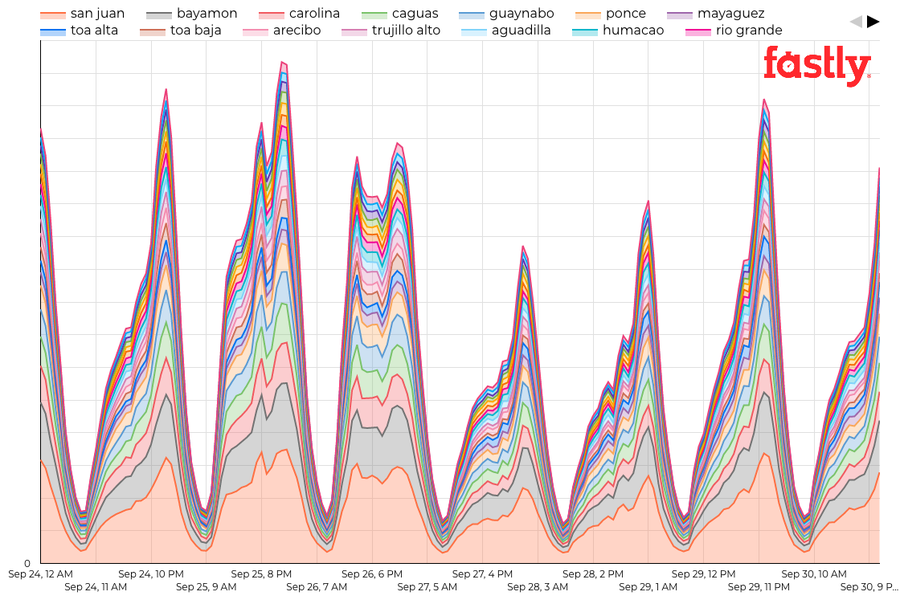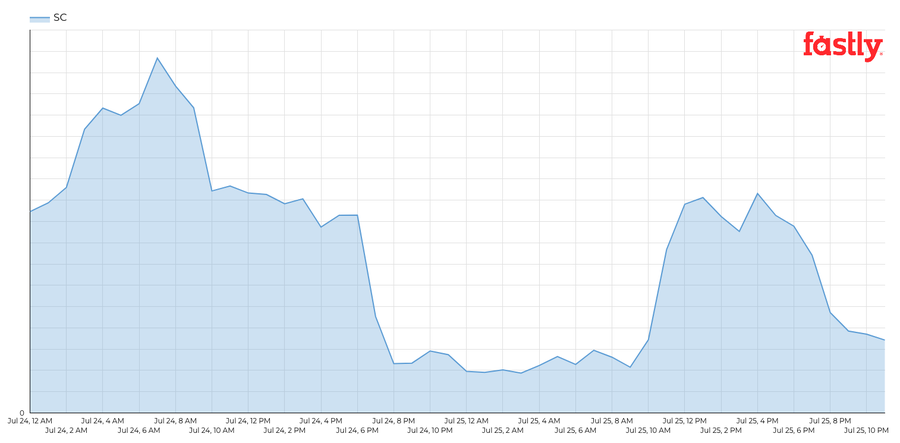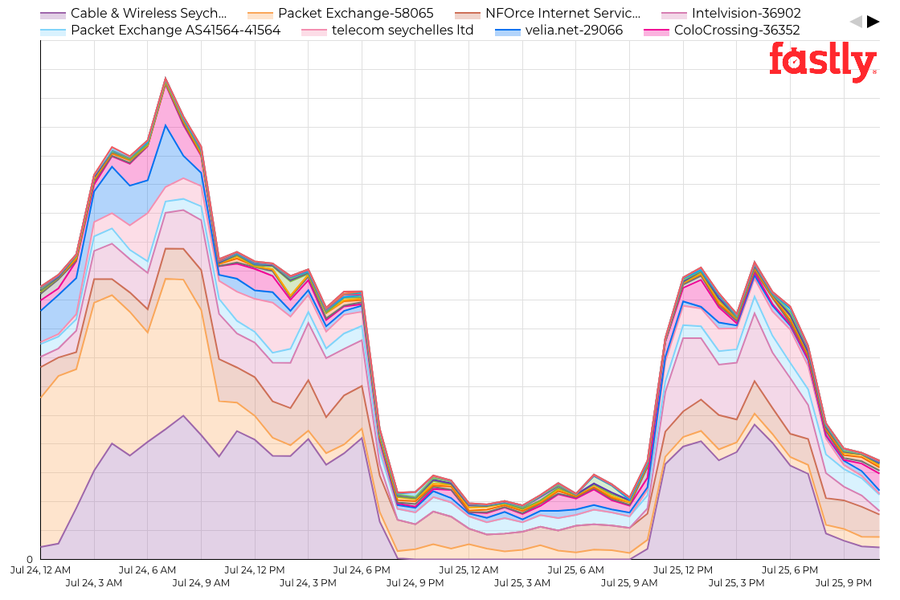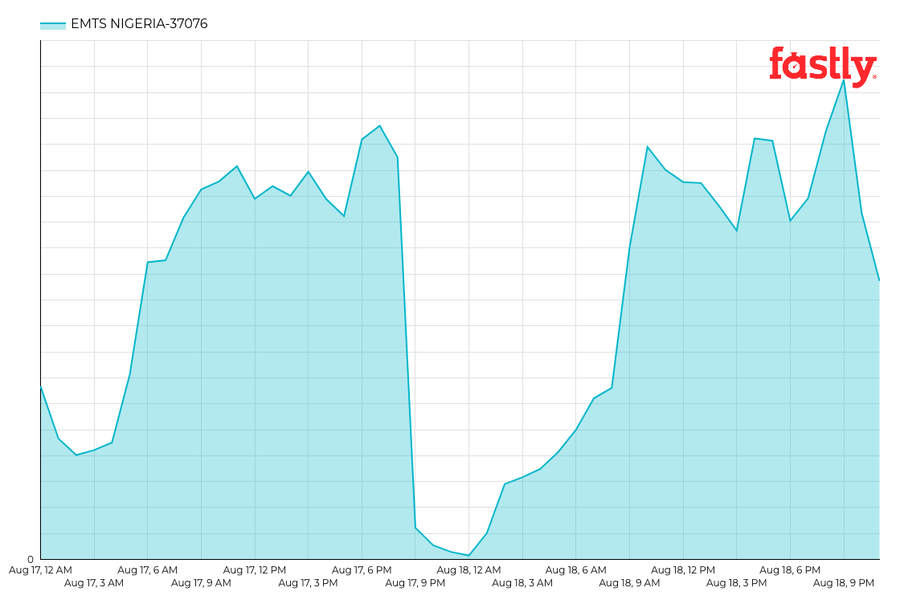Going offline: internet disruptions we saw in Q3 2021

Sr. Director, Data Insights, Fastly
Small internet disruptions occur every day at a local level, frustrating users while they are unable to access their favorite social media, news, or ecommerce site, or send messages to friends, family, or colleagues. These are often resolved quickly and are hard for external observers to capture through monitoring or traffic analysis.
But all too frequently, large-scale disruptions also occur. Some may be unavoidable, such as those caused by power outages or infrastructure damage, while others are premeditated, caused by local or national governments ordering the shutdown of telecommunications services, including internet connectivity. Either way, these large-scale internet disruptions can force millions of people offline for multiple hours, or even days or weeks. It’s important for companies and end users to be aware of and understand these issues so they can spot patterns, understand major trends, and as a global community, help mitigate these disruptions that interrupt essential aspects of daily life.
At Fastly, we do just that: we monitor these worldwide incidents, and share what we’re seeing as transparently as possible with our community. During the third quarter of 2021, a number of internet disruptions were observed around the world for a variety of planned and unplanned reasons. Here’s a selection of what we saw:
Power outages
Reliable electrical power is, unsurprisingly, critical for reliable internet connectivity. This holds true at the provider level, where backup generators may be called upon to keep key infrastructure components up and running, as well as at the user level to keep routers and computers online and cell phones charged to enable mobile internet access. When power outages occur, their impacts are often immediately evident through shifts in Fastly traffic to the impacted area.
On August 8, ZESCO Limited, the state-owned power company in Zambia, tweeted a statement about the restoration of power following a system failure that caused a loss of power to most parts of the country. This multi-hour power outage impacted connectivity during that afternoon as shown in the graphs below, with traffic at the state and city level lower during that time than on surrounding days. (The numbers on the state graph represent UN/LOCODE ISO 3166-2 subdivision codes.)

Fastly traffic to Zambia (state level), August 7-9, 2021

Fastly traffic to Zambia (city level), August 7-9, 2021
But it’s not just system failures that trigger these events. Severe weather conditions often cause power outages due to infrastructure damage, and the August 29 landfall of Hurricane Ida in New Orleans was no different. As the graphs below illustrate, Fastly traffic to users in New Orleans began to decline on the 28th, as residents of the city began to evacuate. However, a more significant loss of traffic occurred on the 29th, as power company Entergy published an update noting that “all eight transmission lines that deliver power into the New Orleans area are currently out of service.” After approximately two weeks, peak traffic levels returned to levels seen before Hurricane Ida, and Entergy noted that “two weeks after Hurricane Ida struck Louisiana, our workforce has restored nearly 90% or 823,000 of the 948,000 total customers who lost power.”

Fastly traffic to New Orleans, Louisiana, August 26-September 14, 2021
Looking at Fastly traffic to New Orleans by destination network provider during this period reveals some interesting insights as well. Prior to the arrival of Hurricane Ida, users on Cox Communications consumed the majority of Fastly traffic destined for New Orleans. However, damage to Entergy’s power infrastructure as well as Cox poles and wires drove this traffic volume to near zero for several days. Those users who were able to connect to the internet did so through mobile network providers: Fastly saw nominal but consistent levels of mobile traffic to New Orleans until wired connectivity began to recover in earnest.

Fastly traffic by destination network to New Orleans, Louisiana, August 26-September 14, 2021
Electricity usage itself is also something to pay attention to. At the end of September, increased demand on Puerto Rico’s fragile electrical infrastructure caused a number of power outages across the territory. According to Luma Energy — the company responsible for the island’s electrical power transmission and distribution system — parts of the power grid needed to be disconnected to relieve pressure on the system. The graphs below show peak Fastly traffic levels from Puerto Rico dropping by ~20% on September 26, with peak traffic on the following days an additional 15-25% lower. The “shape” of traffic on September 26 also differs from the surrounding days, with peaks seen at 1500 and 0000 GMT (1100 and 2000 local time), whereas the other days saw a single spike at 0100 GMT (2100 local time). It’s unclear if this unusual traffic pattern is related to the power outages, however.

Fastly traffic to Puerto Rico (city level), September 24-30, 2021

Fastly traffic by destination network to Puerto Rico, September 24-30, 2021
Cable/fiber cuts
CANTV is the state-run telephone and internet service provider in Venezuela. On July 14, they tweeted that a fiber optic cable cut affected internet service in various regions. Fastly traffic from CANTV’s network shows that traffic dropped sharply around 1600 UTC (1200 local time) and returned to normal levels around 0000 UTC (2000 local time).
In addition to this disruption, CANTV also reported that a “triple” fiber optic cable cut impacted internet services on September 21.

Fastly traffic to CANTV in Venezuela, July 13-15, 2021
On July 22, the Center for Applied Internet Data Analysis shared that their monitoring detected two internet disruptions in Namibia, one beginning just before 2300 UTC (0100 local time), and the other starting at 0200 UTC (0400 am local time). You can see these in the center of the graph below.

Fastly traffic to Namibia, July 21-22, 2021
Further research showed that Cameroon and the Republic of the Congo experienced disruptions to internet connectivity at the same time, as evident in the graphs below. When simultaneous disruptions of this type occur, we can frequently trace the cause back to network infrastructure common to all three countries, such as a submarine cable. In reviewing the information available on the TeleGeography Submarine Cable Map site, we find that the West Africa Cable System (WACS) lands in all three countries. Although a formal announcement of a root cause was not published, a problem with the WACS cable is the likely culprit, as similar issues have impacted connectivity to the same countries in the past.

Fastly traffic to Cameroon, July 21-22, 2021

Fastly traffic to Republic of the Congo, July 21-22, 2021
While unexpected damage to a submarine cable can disrupt internet connectivity, scheduled cable maintenance can also have the same impact. During the weekend of July 24-25, the Seychelles Cable System Company performed maintenance work on the Seychelles East Africa System (SEAS) submarine cable, which connects Seychelles, an island nation, to Tanzania on the African continent. The graphs below show that Fastly traffic to Seychelles was disrupted between approximately 1800 UTC (2200 local time) on July 24 until around 1200 UTC (1600 local time) on July 25, and that during the maintenance period, traffic to telecommunications company Cable & Wireless Seychelles disappeared completely.

Fastly traffic to Seychelles, July 24-25, 2021

Fastly traffic by destination network to Seychelles, July 24-25, 2021
On the evening of August 17 through the morning of the following day, Fastly traffic to EMTS Nigeria (Emerging Markets Telecommunication Services Ltd., which does business as “9mobile”) suffered a significant disruption — including a near complete loss of traffic for approximately three hours, as illustrated in the graph below. According to a Facebook post from 9Mobile, damage to their fiber infrastructure caused the internet disruption.

Fastly traffic to EMTS Nigeria/9Mobile in Nigeria, August 17-18, 2021
Exam cheating
As discussed in our post in Q2, Syria has been known to shut down the internet nationwide to prevent cheating on exams, and has done so since at least 2016. In early August, Syria experienced several internet disruptions that were reportedly related to a second round of exams for those that failed the first round (in May/June). The graph below shows Fastly traffic for the first week of August from Syrian Telecom, with a complete loss of traffic on August 1st, 3rd, and 5th occurring between 0200-0500 UTC (0500-0800 local time). Because Syrian Telecom is the government-affiliated telecommunications provider within the country and acts as the primary gateway for internet traffic to and from Syria, this shutdown effectively cut the entire country off from the internet during the three hours that it took place.

Fastly traffic to Syrian Telecom, August 1-7, 2021
India is no stranger to internet shutdowns either, with SFLC.in’s tracking site recording over 500 regional shutdowns over the last 10 years, often in response to local political unrest. However, in September, internet connectivity across multiple cities in Rajasthan state was shut down for several hours to prevent cheating on the Rajasthan Teacher Eligibility Test (REET), an exam for those interested in becoming a primary or secondary school teacher at government-run schools.
The graph below shows traffic to Fastly from five Indian cities: Jaipur, Alwar, Ajmer, Sikar, and Nagaur, and lower traffic levels are clearly visible during the duration of the shutdown, which took place between 0230-1130 GMT (0800-1700 local time). While this shutdown may have prevented some candidates from cheating, others were undeterred and turned to alternative technological solutions — reports indicate that multiple test takers were caught with Bluetooth devices embedded in their footwear. A similar, but shorter, internet shutdown was also put into place in Arunachal Pradesh on August 1 to prevent cheating on the Combined Graduate Level (CGL) Examination.

Fastly traffic to Jaipur, lwar, Ajmer, Sikar, and Nagaur, India, September 25-27, 2021
Government-directed disruptions
Governments often shut down internet connectivity in response to planned or active protests. On July 11, Cuba’s government took such steps in response to what were reportedly the biggest anti-government protests on the island nation in decades. The graph below shows Fasty traffic to Empresa de Telecomunicaciones de Cuba S.A. (ETECSA), a state-run company that is the country’s main provider of telecommunications services. You can see a complete loss of traffic from the network starting at approximately 2000 UTC (1600 local time) and lasting for nearly half an hour. Although some brief traffic spikes are visible, traffic volumes remain at a lower than expected level until approximately 2230 UTC (1830 local time).

Fastly traffic to Empresa de Telecomunicaciones de Cuba S.A., July 11, 2021
A similar situation occurred at the end of that week as well — although on July 17, it was a government-organized rally, rather than a citizen protest. In the graph below, you can see two additional disruptions to connectivity during the midday and evening of the 17th. The first one lasted just over three hours, from 1400 UTC until just after 1700 UTC (1000-1300 local time), while the second started around 2100 UTC (1700 local time) and ended just after 2330 UTC (1930 local time).
Fastly traffic data shows a third significant internet disruption on July 26, between approximately 1830 and 1945 UTC (1430-1545 local time). Although no protests were recorded that day, it’s the anniversary of when Fidel Castro's rebel fighters launched an attack against then-President Fulgencio Batista in 1953, beginning the communist revolution on the island.

Fastly traffic to Empresa de Telecomunicaciones de Cuba S.A., July 17, 2021

Fastly traffic to Empresa de Telecomunicaciones de Cuba S.A., July 26, 2021
At the end of August in South Sudan, activists called for protests against President Salva Kiir's government, calling for his resignation. Coincident with this unrest, the graph below shows a disruption to internet connectivity during the evening of August 29, with traffic to Fastly from MTN South Sudan dropping to zero between 1900 and 2200 UTC (2100-0000 local time). Although the South Sudanese government claimed that the internet shutdown had nothing to do with the protests, citing “technical problems,” there was no communication from MTN South Sudan on its Facebook or Twitter accounts indicating any sort of infrastructure damage or system misconfiguration.

Fastly traffic by destination network to South Sudan, August 28-30, 2021
Elsewhere, governments of several Nigerian states shut down internet services in late August into September to stem “bandit” attacks, with the aim of helping local security forces crack down on gangs of bandits by preventing coordination. States including Zamfara, Katsina, and Sokoto implemented such shutdowns, the impacts of which are visible in the graphs below.
In Zamfara, Fastly traffic to MTN Nigeria effectively disappears on August 30. Katsina experienced a similar traffic pattern, starting on September 13. And in Sokoto, MTN Nigeria traffic fell to zero on September 20. The shutdowns don’t appear to be complete, however, as a nominal amount of traffic to Airtel Networks Nigeria and other smaller providers is still visible within the graphs.

Fastly traffic by destination network in Zamfara, Nigeria, August 1-September 30, 2021

Fastly traffic by destination network in Katsina, Nigeria, August 1-September 30, 2021

Fastly traffic by destination network in Sokoto, Nigeria, August 1-September 30, 2021
Going online during lockdown
In covering drops in Fastly traffic caused by internet shutdowns, outages, and other disruptions, it’s hard to illustrate the importance of the internet to everyday life, and what the citizens of a country or region lose when connectivity is restricted or removed. However, increased traffic volumes underscore that story, as we saw in New Zealand when the country was placed into the “toughest, level four lockdown” on August 18 after the country's first coronavirus case in six months was reported in Auckland.
As highlighted in the graph below, peak Fastly traffic levels for New Zealand jumped by around 20% starting on the 18th. Initially scheduled to be a three-day national lockdown, the duration extended through the end of the month as new cases were reported. With significant restrictions on where they could go, New Zealand’s citizens turned to the internet for news, entertainment, shopping, and social interaction.

Fastly traffic to New Zealand, August 1-31, 2021
Conclusion
Although the internet disruptions covered here drove people offline in various countries around the world, a renewed COVID lockdown in New Zealand drove people online. This echoes behavior that we observed a year and a half ago as COVID-19 began to spread rapidly across the globe, when school closures and stay-at-home orders drove people online to work, learn, shop, and more.
Internet outages caused by loss of power or infrastructure damage may be largely unavoidable, but that’s not the case with intentional internet shutdowns ordered by governments — and they’re often incredibly damaging. We will continue to use our data to bring increased visibility to internet disruptions around the world, supporting efforts to fight such actions.